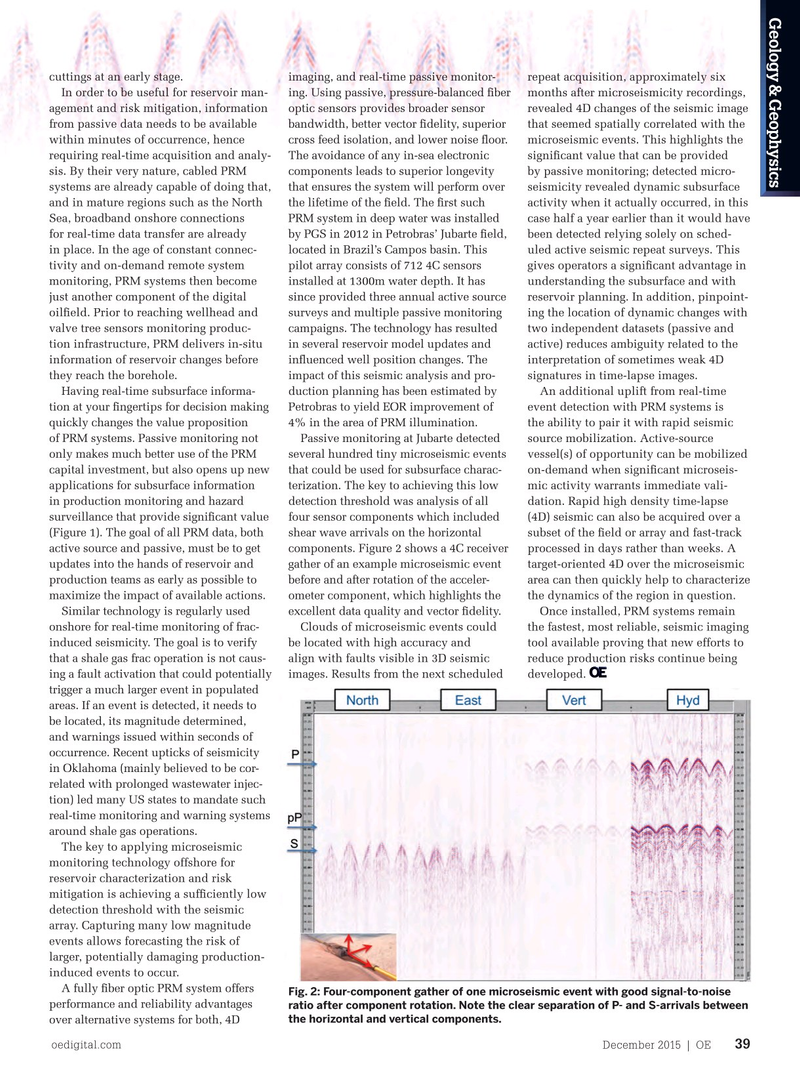
Page 37: of Offshore Engineer Magazine (Dec/Jan 2015)
Read this page in Pdf, Flash or Html5 edition of Dec/Jan 2015 Offshore Engineer Magazine
Geology & Geophysics cuttings at an early stage. imaging, and real-time passive monitor- repeat acquisition, approximately six
In order to be useful for reservoir man- ing. Using passive, pressure-balanced ? ber months after microseismicity recordings, agement and risk mitigation, information optic sensors provides broader sensor revealed 4D changes of the seismic image from passive data needs to be available bandwidth, better vector ? delity, superior that seemed spatially correlated with the within minutes of occurrence, hence cross feed isolation, and lower noise ? oor. microseismic events. This highlights the requiring real-time acquisition and analy- The avoidance of any in-sea electronic signi? cant value that can be provided sis. By their very nature, cabled PRM components leads to superior longevity by passive monitoring; detected micro- systems are already capable of doing that, that ensures the system will perform over seismicity revealed dynamic subsurface and in mature regions such as the North the lifetime of the ? eld. The ? rst such activity when it actually occurred, in this
Sea, broadband onshore connections PRM system in deep water was installed case half a year earlier than it would have for real-time data transfer are already by PGS in 2012 in Petrobras’ Jubarte ? eld, been detected relying solely on sched- in place. In the age of constant connec- located in Brazil’s Campos basin. This uled active seismic repeat surveys. This tivity and on-demand remote system pilot array consists of 712 4C sensors gives operators a signi? cant advantage in monitoring, PRM systems then become installed at 1300m water depth. It has understanding the subsurface and with just another component of the digital since provided three annual active source reservoir planning. In addition, pinpoint- oil? eld. Prior to reaching wellhead and surveys and multiple passive monitoring ing the location of dynamic changes with valve tree sensors monitoring produc- campaigns. The technology has resulted two independent datasets (passive and tion infrastructure, PRM delivers in-situ in several reservoir model updates and active) reduces ambiguity related to the information of reservoir changes before in? uenced well position changes. The interpretation of sometimes weak 4D they reach the borehole. impact of this seismic analysis and pro- signatures in time-lapse images.
Having real-time subsurface informa- duction planning has been estimated by An additional uplift from real-time tion at your ? ngertips for decision making Petrobras to yield EOR improvement of event detection with PRM systems is quickly changes the value proposition 4% in the area of PRM illumination. the ability to pair it with rapid seismic of PRM systems. Passive monitoring not Passive monitoring at Jubarte detected source mobilization. Active-source only makes much better use of the PRM several hundred tiny microseismic events vessel(s) of opportunity can be mobilized capital investment, but also opens up new that could be used for subsurface charac- on-demand when signi? cant microseis- applications for subsurface information terization. The key to achieving this low mic activity warrants immediate vali- in production monitoring and hazard detection threshold was analysis of all dation. Rapid high density time-lapse
Fig. 1: Time scale of decision making in oil? eld operations and associated relative surveillance that provide signi? cant value four sensor components which included (4D) seismic can also be acquired over a value vs. di

 36
36

 38
38